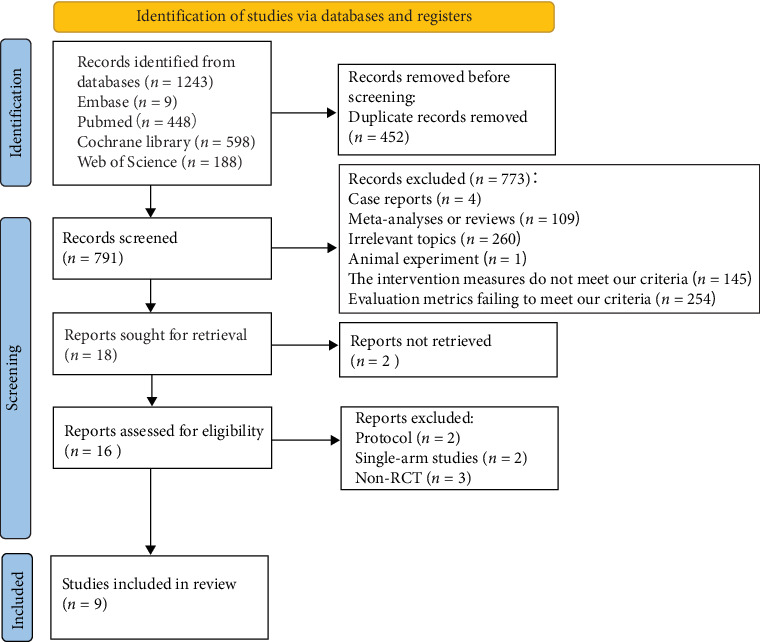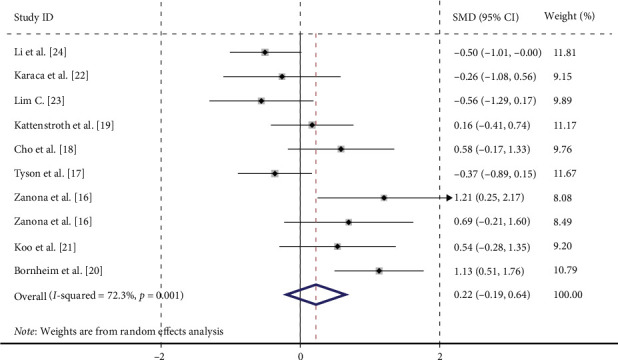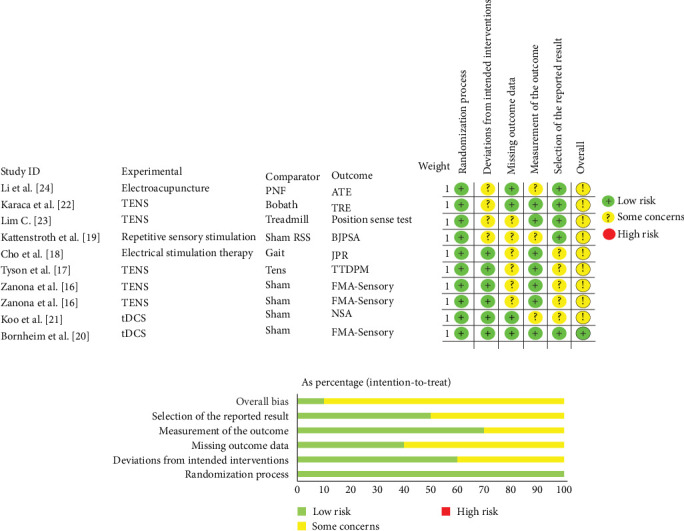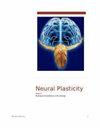神经调节技术在脑卒中后本体感觉障碍治疗中的应用:随机对照试验的荟萃分析。
摘要
背景与目的:脑卒中后,本体感觉障碍会损害患者准确、迅速地感知运动速度和方向以及肢体空间位置的能力。这种损伤通常导致运动功能障碍,包括平衡和姿势控制缺陷,严重影响患者的日常生活活动(ADLs)和生活质量。神经可塑性是影响脑卒中后功能恢复的关键因素。近年来,以增强神经可塑性为目标的神经调节技术已成为一个重要的研究热点。本研究旨在对神经调节技术治疗脑卒中患者本体感觉障碍的疗效进行荟萃分析。方法:系统检索PubMed、Embase、Cochrane Library和Web of Science,研究神经调节技术对脑卒中患者本体感觉损伤的影响。搜索范围从每个数据库建立之初到2024年12月。主要观察指标是本体感觉的改变。结果:本meta分析共纳入9项随机对照试验(RCTs)。一项研究比较了两种不同的神经调节技术,结果提取了10个不同的数据集。总共有360名患者参与了这些研究。其中,治疗组182例患者接受神经调节技术联合常规康复治疗,对照组178例患者单独接受常规康复治疗。meta分析显示,神经调节技术联合常规康复与单独常规康复的疗效无显著差异(标准化平均差[SMD] = 0.221,95% CI = -0.194 ~ 0.636, p=0.296)。基于脑卒中病程分期的亚组分析显示两组间无显著差异(急性期:SMD = 0.303, 95% CI = -1.300 ~ 1.905, p=0.711;亚急性期:SMD = 0.351, 95% CI = -0.200 ~ 0.903, p=0.212;慢性期:SMD = -0.047, 95% CI = -0.634 ~ 0.539, p=0.874)。基于神经调节技术类型的亚组分析显示,电针、重复经颅磁刺激(rTMS)和经颅直流电刺激(tDCS) 3种特异性技术对脑卒中后本体感觉障碍的改善有效:SMD = -0.504, 95% CI = -1.006 ~ -0.002, p=0.049;rTMS组:SMD = 1.207, 95% CI -2.168 = 0.246, p = 0.014;tDCS组:SMD = 0.894, 95% CI -1.465 = 0.323, p = 0.002)。结论:神经调节技术治疗脑卒中后本体感觉障碍的疗效差异无统计学意义。此外,在不同阶段的卒中干预中没有观察到显著差异。然而,亚组分析表明,电针、rTMS和tDCS可能有效地治疗脑卒中后本体感觉障碍。因此,建议在临床实践中优先考虑这些技术。



Background and Objective: After a stroke, proprioceptive disorders can impair patients' ability to perceive the speed and direction of movement accurately and promptly, as well as the spatial position of their limbs. This impairment often leads to motor dysfunction, including balance and postural control deficits, which severely affect patients' activities of daily living (ADLs) and quality of life. Neural plasticity is a key factor influencing poststroke functional recovery. In recent years, neuromodulation techniques targeting the enhancement of neural plasticity have emerged as a major research focus. This study aims to conduct a meta-analysis of the efficacy of neuromodulation techniques in treating proprioceptive disorders in stroke patients. Methods: A systematic search was conducted in PubMed, Embase, the Cochrane Library, and Web of Science for studies investigating the effects of neuromodulation techniques on proprioceptive impairment in stroke patients. The search spanned from the inception of each database to December 2024. The primary outcome measure was the change in proprioception. Results: In this meta-analysis, a total of nine randomized controlled trials (RCTs) were included. One study compared two different neuromodulation techniques, resulting in the extraction of 10 distinct datasets. Overall, 360 patients were involved in these studies. Specifically, 182 patients in the treatment group received neuromodulation techniques combined with conventional rehabilitation, while 178 patients in the control group received conventional rehabilitation alone. The meta-analysis revealed no significant difference in the efficacy of neuromodulation techniques combined with conventional rehabilitation compared to conventional rehabilitation alone(standardized mean difference [SMD] = 0.221,95% CI = -0.194 to 0.636, p=0.296). The subgroup analysis based on the stage of the stroke course revealed no significant differences between the two groups(acute stage: SMD = 0.303, 95% CI = -1.300 to 1.905, p=0.711; subacute stage: SMD = 0.351, 95% CI = -0.200 to 0.903, p=0.212; chronic phase: SMD = -0.047, 95% CI = -0.634 to 0.539, p=0.874). Subgroup analysis based on the types of neuromodulation techniques revealed that three specific techniques, electroacupuncture, repetitive transcranial magnetic stimulation (rTMS), and transcranial direct current stimulation (tDCS), were effective in improving proprioceptive disorders after stroke electroacupuncture group: SMD = -0.504, 95% CI = -1.006 to -0.002, p=0.049; rTMS group: SMD = 1.207, 95% CI = 0.246-2.168, p=0.014; tDCS group: SMD = 0.894, 95% CI = 0.323-1.465, p=0.002). Conclusion: No statistically significant difference was found in the efficacy of neuromodulation techniques for treating proprioceptive disorders after stroke. Additionally, no significant differences were observed in the intervention across different stages of stroke. However, subgroup analysis indicated that electroacupuncture, rTMS, and tDCS may be effective in managing proprioceptive disorders poststroke. Therefore, it is recommended to prioritize these techniques in clinical practice.

 求助内容:
求助内容: 应助结果提醒方式:
应助结果提醒方式:


